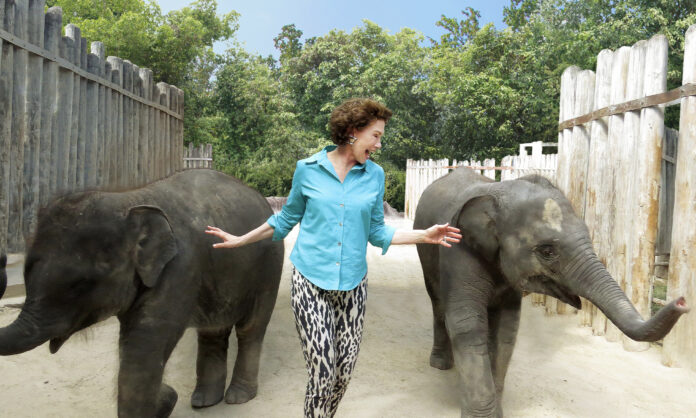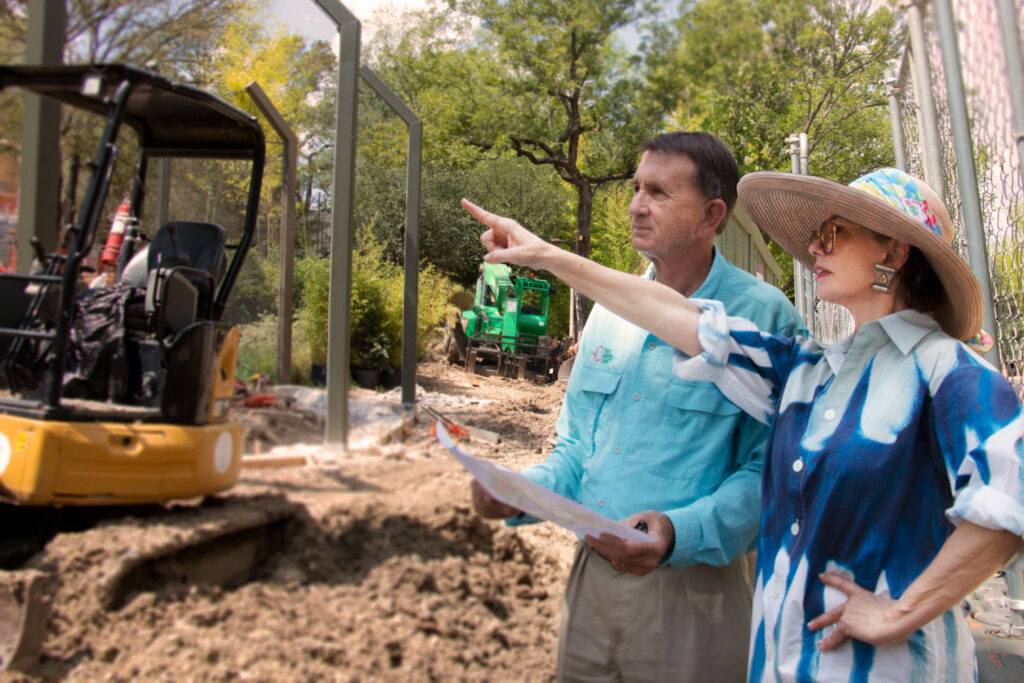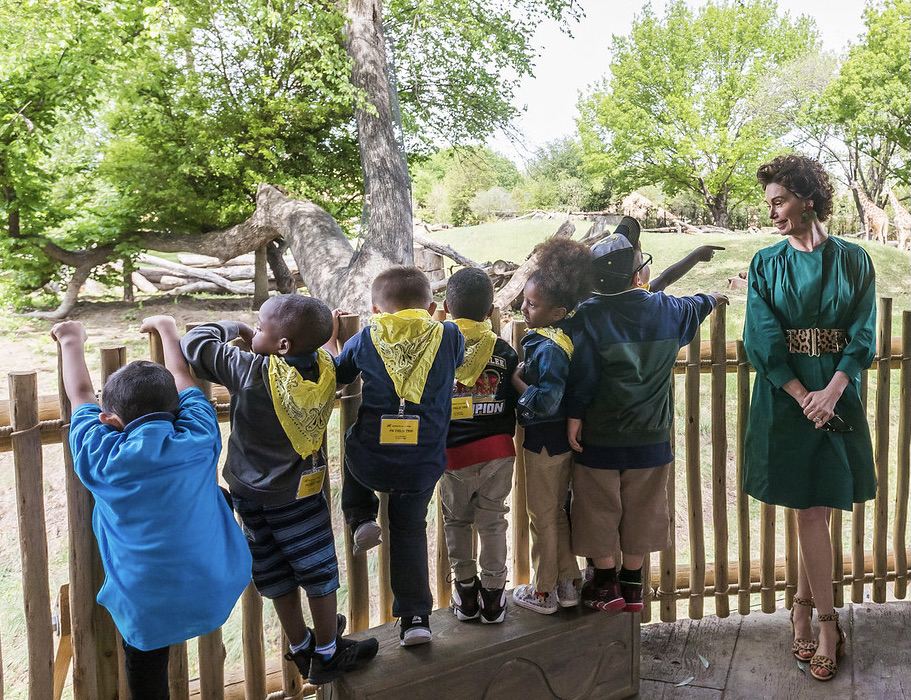Growing up in San Antonio and spending memorable weekends and summers on her family’s ranch in South Texas, Ramona Seeligson developed a deep love of horses and all the wildlife that surrounded her there.
She also shared her oilman father Arthur Seeligson Jr.’s fondness for breeding and racing thoroughbred horses, a pursuit that continues for her today.
So it’s no wonder that a 1983 date with her fiancé, Lee Bass, to the aging and rundown Fort Worth Zoo would redefine her priorities in life.
The future Mrs. Bass was so distressed by the dilapidated conditions and lagging care for the animals, which didn’t meet U.S. Department of Agriculture guidelines or even city code requirements, that she resolved to transform the zoo.
“When I was growing up in San Antonio, our zoo wasn’t like what I saw here in Fort Worth,” she said. “I knew we could do much better.”
The transformation was spectacular, to say the least. Today, the Fort Worth Zoo is a model of highest-quality animal care where conservation is a top priority and throngs of guests visit every year. It is consistently ranked among the best in the country.
The zoo has also made its mark as one of the most popular attractions in the Dallas-Fort Worth area. Its average annual economic impact for the city of Fort Worth in 2021-22 is estimated at $228.5 million.
The Fort Worth Zoo opened its doors in Forest Park in 1909, owned and operated by the city. The original zoo – it’s the longest, continuously operating zoo site in Texas – featured one lion, two bear cubs, an alligator, a coyote, a peacock and some rabbits.
In 1939, the Fort Worth Zoological Association was formed to help boost financial support for the zoo. But by the early 1980s, the zoological association was nearly defunct, financial support from the city was waning and conditions at the zoo were deteriorating.
That was the zoo that horrified Ramona Bass, who says the Fort Worth Zoo was probably no worse off back then than many city-owned zoos around the country that similarly struggled with funding.
But that realization did not comfort then-28-year-old Ramona or provide a pathway for improvement.
“I asked Lee, ‘What can I do?’ she recalled. “He said, ‘Call Harry Tennison.’”
A renowned wildlife conservationist widely known as the “Father of the Black Rhino,” Tennison agreed to help. So did his daughter, Kit Moncrief.
With other recruits on-board as well, the Fort Worth Zoological Association was revitalized with a new board and executive committee. Fundraising ramped up and improvement plans were made.
Ramona and Kit both were married to members of prominent and powerful Fort Worth families – Ramona to the youngest of the four sons of businessman/philanthropist Perry Bass and Kit to Charles Moncrief of the Moncrief Oil empire – and both were destined to become renowned philanthropists in their own right, but that didn’t make drumming up support for the worn-out zoo an easy task.
“Kit and I were young and we were trying to raise money,” Ramona recalled. “Everywhere we went, people would ask, ‘Who are these kids?’”
Undeterred, Ramona, Kit and philanthropist Whitney Hyder More (whose mother Martha Hyder was the driving force behind the Van Cliburn International Piano Competition) never wavered and in 1985 organized the first Zoo Ball fundraising gala. The Zoo Ball remains the organization’s premier fundraising event.
In 1989, the zoological association took over construction management of the World of Primates exhibit to keep the project on track and within budget.
The following year was pivotal to the zoo’s transformation as Ramona Bass and Kit Moncrief took over as co-chairs of the zoological association’s board of directors.
“We did try to work within the limitations of the city for four or five years,” she said. “But there was always a lack of funding and a lack of will to do more because people liked their zoo the way it was.”
And then came a battle with the neighborhood over improvements that would expand the zoo’s footprint and reduce open space in Forest Park.
“We did have resistance from the neighborhood and the City Council,” Bass said. “The neighborhood people didn’t want change.”
Amid the acrimony, a tragedy occurred at the zoo. In 1990, a serval cat, native to Africa and resembling a small cheetah, froze to death on its concrete pad.
“That was it – it was the last straw,” Bass said. “Something had to give.”
The zoological association approached the city with a proposal to create a public-private partnership to manage the zoo. Association president Ardon Moore negotiated a contract with the stipulation that Lee and Ramona Bass would underwrite the financial risk of the partnership.
Ramona credits then-Mayor Bob Bolen and Councilman Bert Williams with shepherding approval of the plan, which was the city’s first public-private partnership and ultimately a model for zoos and museums nationwide.
The zoological association finally took operational control of the zoo in October 1991 and shut down the facility for the first time in its history.
The following year, the zoo staged a grand re-opening celebrating the “New Zoo in ’92,” introducing two groundbreaking new exhibits, the World of Primates and Asian Falls (both have since closed) accompanied by 64 acres of improvements that included shade structures, cooling misters and new food, beverage and concession areas – all demonstrating the zoo’s commitment to the visitor experience.
The “new zoo” also showcased the zoo’s commitment to higher standards of animal care, habitat design and education programming made possible by privatization.
In the first year after re-opening, the zoo welcomed more than a million visitors. It has continued to draw that many visitors each year since.
To mark the 30th anniversary of privatization this year, the zoo has been highlighting its accomplishments across its 64-acre grounds. Visitors can find historical photos and a timeline of significant events, including new habitat openings, conservation milestones and significant animal births.
Visitors can also search for the zoo’s 30-year residents, animals who were residing at the zoo in 1992 and continue to live there, including Winifred, a western lowland gorilla; hippos Daisy and Jonesy; Mtoto, a southern black rhino; and orangutans Chantek and PT. Signs identifying “30-Year Club” members are posted at their habitats.
Every year since privatization has also brought additional improvements, more recognition, new events and education programming as well as a broadening commitment to conservation efforts.
The earliest post-privatization accomplishments include the inaugural Boo at the Zoo in 1992, a perennial family-friendly event, followed by the opening of Raptor Canyon, Asian Rhino Ridge, the Portraits of the Wild Art Gallery, the Gloria Lupton Tennison Education Center, Flamingo Bay, the Burnett Animal Health Science Center and inauguration of the Zoo Run.
In 2001, Texas Wild! opened. This eight-acre space is home to about 300 animals and is an educational and immersive experience that explores the abundant wildlife of Texas. Also that year, the Seeligson Conservation Fund, honoring the memory of Ramona Bass’ father, Arthur A. Seeligson, was established. The fund supports the efforts of organizations and individuals to protect native Texas species, the inspiration behind Texas Wild!
The groundbreaking exhibit was established to showcase the abundant variety of indigenous animal species in Texas and the importance of wildlife stewardship through conservation and management.
Zoo leaders branded Texas Wild! as “edzootainment,” an environmental education experience combined with entertainment and hands-on fun.
After Texas Wild! came the addition of more exhibits and events, including the Great Barrier Reef and Penguins and the introduction of the annual Beastro, a live music and food-tasting event that helps support the zoo’s conservation and education efforts.
Debuting in 2010 was Museum of Living Art (MOLA), a 30,000-square-foot indoor-outdoor space dedicated to reptiles and amphibians. This space houses about 5,000 animals, representing about 200 species, and includes dedicated areas for conservation of the world’s most endangered species.
To celebrate the opening of MOLA, a 40-foot-long, 2,600-pound iguana sculpture created by Bob “Daddy-O” Wade was flown over Forest Park and the zoo. The sculpture, named “Iggy,” now resides atop the Burnett Animal Health Science Center, greeting visitors to the zoo.
Other additions include the Outdoor Learning Theater; Texas Nature Traders, which encourages outdoor exploration; Safari Splash, a water play area; and Toyota Children’s Petting Ranch.
In 2016, the single largest capital campaign in the zoo’s history was launched to carry out A Wilder Vision, an ambitious $130 million project that will result in renovated and reimagined habitats, additional exhibit space and special exhibit space, new dining areas and inventive ways for guests to learn and interact with the animals. Lee and Ramona Bass donated $30 million toward the cost.
The four-phase project has already introduced African Savanna in 2018. The 10-acre habitat is home to giraffes, antelope, hippos, Southern black rhinos, meerkats, flamingos and other birds.
In 2021, Elephant Springs debuted as the second phase of the project, tripling the habitat space for the elephant herd and the greater one-horned rhino.
Asian Predators and Hunters of Africa is projected to open in 2023, followed by Forests and Jungles in 2025.
One of the most impactful moves for the zoo was the hiring of Michael Fouraker in 1993. A dedicated conservationist, Fouraker joined the zoo as director of animal programs and conservation. In 2001, he was promoted to executive director.
Besides managing 300 full-time employees along with 350 part-time seasonal workers and an army of volunteers, Fouraker oversees the care and feeding of roughly 7,000 animals representing more than 500 species.
During his tenure, countless baby animals have been born at the zoo, including Bluebonnet, the first Asian elephant, who arrived in 1998.
Two more Asian elephants, Belle and Bowie, arrived in 2013, with Bowie’s birth establishing a third-generation herd at the zoo. Brazos, a fourth Asian elephant, was born in 2021. Gus, the first western lowland gorilla born at the zoo, arrived in 2015.
Fouraker’s responsibilities also reach far beyond the 64 acres of the grounds as he leads zoo scientists in carrying out the zoo’s vast commitment to conservation, which includes breeding initiatives to help sustain endangered species, protecting animals against poaching, and effective wildlife management worldwide.
The zoo’s conservation efforts, through many partnerships and generous financial support, extend to more than 30 countries. The zoo has staff “boots-on-the-ground” involvement with 18 projects at the international, national and state levels.
The zoo has supported conservation to help sustain a variety of species, ranging from elephants to toads. Since 1993, zoo staffers have been involved with the development of seven nonprofit organizations that support individual species conservation by capitalizing on partnerships with corporations, universities, conservation centers, individual donors and other zoos.
Among these nonprofits is the International Elephant Foundation, established along with the zoo and with Fouraker as the founder, first president and a board member.
Some of the others include the International Iguana Foundation, the Turtle Survival Alliance and the Caribbean Wildlife Foundation and Alliance. Fouraker has had leadership roles with these organizations.
The International Rhino Foundation was also established in partnership with the zoo and with Lee Bass as one of the founders. A lifelong conservationist, Lee served for more than a decade on the Texas Parks and Wildlife Commission and his South Texas ranch maintains the most successful breeding program for the Black Rhino in North America.
Since 2009, the zoo has contributed more than $2.4 million to conservation organizations and spent more than $5.9 million on conservation-related expenses, including staffing and equipment.
Fouraker said conservation is one of the three cornerstones of the zoo’s success. The others are entertainment and education.
Bringing it altogether, along with ever-expanding facility upgrades and new programs and immersive opportunities, the zoo has been a draw for visitors well beyond Fort Worth and even the Dallas-Fort Worth area, Fouraker said.
“It’s amazing how many three-generation groups with grandparents, parents and children visit the zoo,” he said. “We also see people come without children – it is a great place for a first date.”
Out-of-state visitors have become increasingly more common at the zoo.
“Over the years, the Fort Worth Zoo’s brand has become so recognizable that it’s now a great draw for people visiting Texas,” said Ardon Moore. “Even school groups come from neighboring states to visit the Fort Worth Zoo, often driving right by zoos in their own state.”
“We regularly hear from out-of-state visitors who have traveled to the Metroplex solely to visit the Fort Worth Zoo,” Moore said.
Fort Worth Mayor Mattie Parker calls the zoo “a treasure.”
“The Fort Worth Zoo is truly a Fort Worth staple, dearly loved by residents, visitors, and even my own family,” Parker said. “One million people each year enjoy the zoo’s opportunities for exploration and education, making it both a destination for drawing tourism from all over the world and a treasure for Fort Worthians to enjoy.
“Over the last 30 years, the entire zoo team, led by the vision of Ramona Bass, has kept raising the bar of excellence, proving itself to be one of the foremost examples of how strong public-private partnerships are foundational to the success of our city.”
Despite the zoo’s popularity as a destination, and its beloved status with the 55,000 people who have purchased zoo memberships, the zoo struggled like many businesses and institutions during the pandemic.
The zoo closed for 11 weeks in 2020 at the beginning of the COVID-19 outbreak. Staffers continued care of the animals during the shutdown.
“Following state and local guidelines, we were eventually able to reopen and guests continued to visit the zoo,” Moore said. “As a primarily outdoor facility, we were able to offer our visitors a safe and comfortable setting.”
“We felt fortunate that we were one of the few attractions in the Metroplex that was in a position to provide families with a fun, engaging activity during that time” Moore said, noting that cleaning protocols were put into place to keep guests safe.
The pandemic slowed progress on the last two phases of A Wilder Vision, delaying final completion until 2025.
“Patience is not a virtue I have,” Ramona Bass said. “But this has taught me to have a little patience.”
The pandemic was one of the zoo’s most formidable challenges but certainly not its only one. With the benefit of experience and quick, level-headed action, the zoo staff has weathered it all.
During flooding caused by torrential rain in August, the stingrays were in danger of drowning but staff kept them safe.
“We’re been through this before,” Fouraker said. “This was our second worst flood. The worst was in 2011.”
Running an operation as large and complex as the Fort Worth Zoo is a difficult job that requires the efforts of many but nearly everyone involved with the zoo says the credit belongs to Ramona Bass.
Her love of animals, her dedication to their care and comfort at the zoo and her commitment to the guest experience have shaped the zoo’s culture and established its reputation for excellence, Moore said.
“From the beginning, she has wanted to provide a “top zoo” to this city that she loves so much,” Moore said.
Bass is unapologetic about her commitment or her ambitions for the zoo.
“I’m so picky,” she admitted. “When it comes down to something like the color of handrails, I would rather it be wonderful and raise money than let it just be mediocre.”
As for the animals, Bass will go the distance for their health and well-being. Once, when one of the elephants got sick and required an antibiotic, zookeepers were finding it impossible to coax the animal to swallow a pill. As a last resort, staffers hid the pill inside a chocolate glazed doughnut.
Still, the elephant refused to eat.
Bass said they finally realized that the elephant would not eat the doughnut until the rest of the herd were treated to doughnuts, too.
“It was doughnuts for everyone” she said. The scheme was successful.
Bass’ devotion to animals has driven the zoo’s extensive involvement with conservation efforts to prevent “a rising tide of extinction,” she said.
The zoo has an important role in helping people understand the importance of animals in the wild to maintaining the balance of nature, Moore noted.
“We believe that when people are entertained and engaged, they will want to learn about wildlife and will feel inspired to care for their animal counterparts in the wild and the habitats they reside in,” he said.
The zoo is also the place where visitors, particularly on Sunday, might run into the woman whose vision and determination has produced for Fort Worth a cherished place of fun, learning and benevolence for animals.
“I love to go to the zoo on Sunday afternoons,” Bass said. “That’s when all the families are here having a great time. When I see that, I feel that we have done a great job.”









